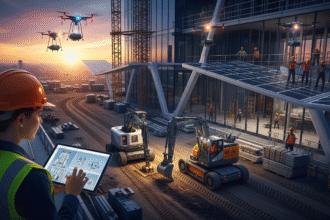The construction industry is undergoing rapid transformation in 2025. As labor shortages persist and productivity demands rise, many routine construction roles are becoming automated. Robots, drones, self‑driving machines, and wearable systems are changing the landscape, and they’re reshaping jobs. In this article, we’ll explore the top ten construction occupations most impacted by automation in 2025, based on expert sources and real‑world implementations.
- 1. Bricklaying and Masonry
- 2. Excavation and Earthmoving
- 3. Material Handling and Logistics
- 4. Site Surveying and Inspection
- 5. Demolition
- 6. Layout and Marking
- 7. Painting and Plastering
- 8. Finishing and Drywall Work
- 9. Infrastructure Inspection and Maintenance
- 10. Wearable Exoskeletons for Labor Assistance
- Why These Jobs Are Being Automated
- Impact on Workers and Skills
1. Bricklaying and Masonry
Bricklaying has long been one of the most time‑intensive and physically demanding tasks on job sites. Companies now deploy robotic systems such as the Semi‑Automated Mason series and Hadrian X that can lay bricks hundreds or even thousands per hour with precise alignment. In Florida, for instance, Hadrian X built an entire house in just one day during a pilot project in early 2025. These robots reduce repetitive labor and deliver consistent wall quality.
2. Excavation and Earthmoving
Heavy earthwork roles, traditionally filled by excavator and bulldozer operators, are increasingly being automated. Built Robotics’ Exosystem transforms standard Caterpillar and John Deere machines into autonomous vehicles capable of digging, grading, and pile driving without a human at the controls. These systems boost efficiency and reduce risks associated with human-operated heavy equipment.
3. Material Handling and Logistics
Transporting materials like bricks, steel beams, and panels across a construction site typically involves manual labor or forklift operations. Now, automated guided vehicles and autonomous mobile robots handle these tasks. In projects from Singapore to the U.S., robotic material handling has cut handling times by up to 30%, reduced accidents, and improved inventory tracking through RFID and AI navigation systems.
4. Site Surveying and Inspection
Drones equipped with LiDAR and high-resolution cameras are being used extensively for surveying, progress tracking, and hazard detection. Automated aerial mapping replaces slower, traditional surveying methods, giving managers real‑time insights into site layout and safety issues. This reduces costly rework and improves decision making.
5. Demolition
Demolition is inherently dangerous, and robots now handle much of the hazardous work. Remote-controlled demolition machines, such as the Brokk series, and specialized robotic arms can safely dismantle structures with high precision, even in unstable environments, minimizing human exposure to dangers.
6. Layout and Marking
Accurate site layout is crucial for foundations and walls. Robots such as Dusty Robotics units can map, mark, and lay out building footprints on floors and slabs with millimeter precision. This eliminates human errors in translating blueprints onto the physical site, speeding up early-stage construction.
7. Painting and Plastering
By 2025, wall‑painting and plastering robots are reaching mainstream use. For example, Singapore’s public housing authority plans to deploy robots at about half of the new Build‑To‑Order sites for painting and plastering tasks from 2025 onward. These machines can coat large wall surfaces quickly and evenly, reducing labor demand and improving finish quality.
8. Finishing and Drywall Work
Companies such as Canvas and Finish Robotics offer automation systems specifically for drywall compound application and finishing. Robots apply and smooth joint compounds on ceilings and walls accurately, reducing manual finishing tasks and ensuring consistency across surfaces in interior construction.
9. Infrastructure Inspection and Maintenance
Robots equipped with vision systems are being deployed to inspect structural elements, welds, and concrete surfaces. Some crawler or drone-based robots can autonomously detect cracks and even perform minor repairs, enabling continuous monitoring without human inspectors entering risky areas.
10. Wearable Exoskeletons for Labor Assistance
Exoskeleton suits, while not fully autonomous, are robotic devices worn by workers to augment strength and reduce fatigue. Especially useful in lifting tasks or repetitive movements, these suits extend worker endurance, reduce musculoskeletal injuries, and enable longer, safer shifts in physically demanding jobs.
Why These Jobs Are Being Automated
First, these tasks are repetitive, structured, and physically demanding, perfect for machines. Robots deliver speed, precision, and consistency at high rates. Second, labor shortages plague many regions, driving firms toward automation to meet project demands. Third, safety concerns in hazardous work motivate the switch; robots reduce injury rates significantly. Fourth, sustainability goals align with automation: 3D printing and controlled material handling reduce waste and lower carbon footprints.
Impact on Workers and Skills
Automation is reshaping rather than obliterating construction careers. Skilled workers are increasingly transitioning into supervisory, robotic‑operator, and technician roles. New job types such as robot maintenance specialist, machine programmer, and site automation coordinator are emerging. Soft skills like adaptability and digital literacy are becoming essential.
In 2025, the greatest shifts in construction automation will be seen in bricklaying, excavation, material handling, site layout, finishing, and inspection tasks. These ten roles, which once relied heavily on manual labor, are being transformed by robotics and AI. While automation displaces routine work, it creates opportunities for more technical and supervisory roles. Embracing these new tools and developing hybrid digital‑physical skills will be vital for workers and organizations preparing for the future of construction.







